
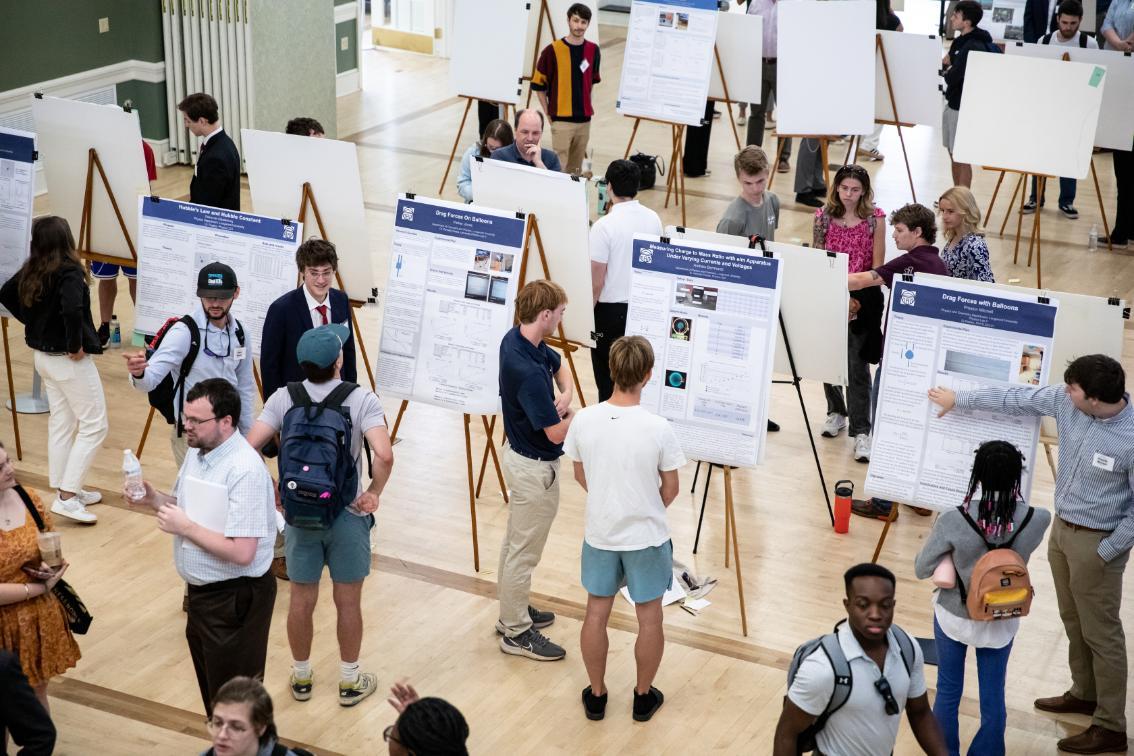
The Spring Student Showcase for Research and Creative Inquiry was held on April 23 and featured more than 475 student presentations from class research and independent research projects. Blackwell Ballroom was buzzing as students presented their research in six hour-long poster sessions throughout the morning and afternoon. Elsewhere on campus presentations took place in Rotunda classrooms, the CSTAC Lab Theater, Molnar Recital Hall, and Bedford Atrium and classrooms.
The showcase featured a mix of poster presentations, oral presentations, performances and visual arts displays from undergraduate and graduate work. Conducting research and other elevated forms of academic work is a hallmark of a Longwood education, whether it takes place in a chemistry lab or a dance studio. Undergraduates who undertake this work gain confidence in working independently, experience in working collaboratively and skills in communicating. Below are 15 interesting things we learned from research presented at the showcase.
Most spiders are not dangerous and can help treat diseases
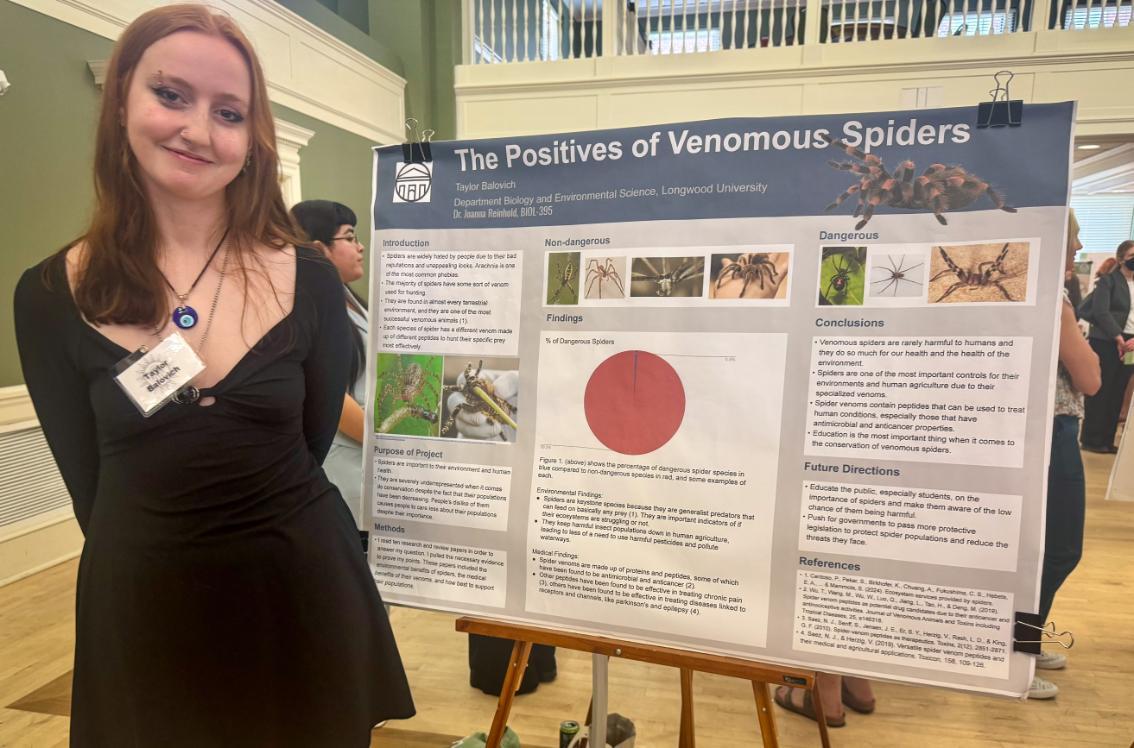
Taylor Balovich ’26, a biology major, loves spiders, so she set out to show that venomous spiders are rarely harmful to humans. Her research showed the percentage of dangerous spiders species is .5 percent compared with nondangerous species. Spiders are a keystone species and are important indicators of their ecosystems. Spider venoms are made up of proteins and peptides, some of which have been found to be antimicrobial and anticancer.
“The positives of venomous spiders”
BIOL 395: Medical and Veterinary Entomology (Dr. Joanna Reinhold)
Physical activity during the early stages of pregnancy can reduce the risk of gestational diabetes
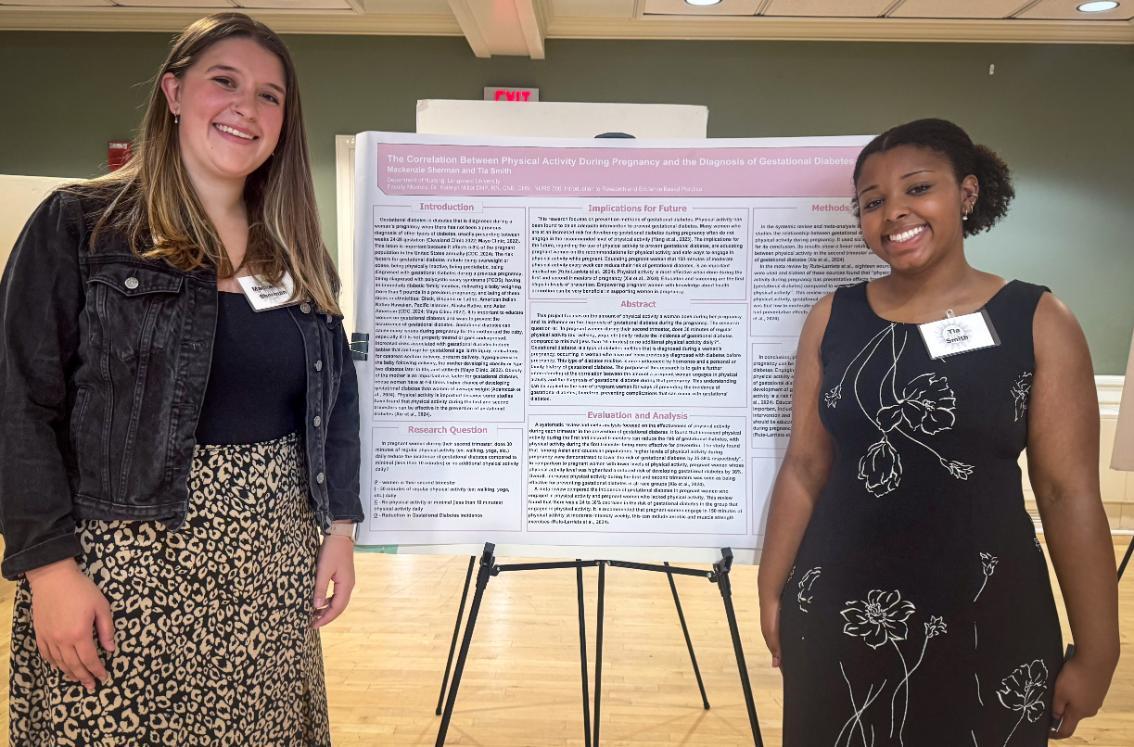
Mackenzie Sherman ’26 and Tia Smith ’26, both nursing majors, found that 30 minutes of regular physical activity (for example, walking and yoga) can reduce the incidence of gestational diabetes compared with minimal or no additional physical activity daily.
“The Correlation Between Physical Activity During Pregnancy and the Diagnosis of Gestational Diabetes”
NURS 360: Introduction to Research and Evidence Based Practice (Dr. Kathryn Miller)
Cellphone ban in schools was a unifying cause for lawmakers in Virginia
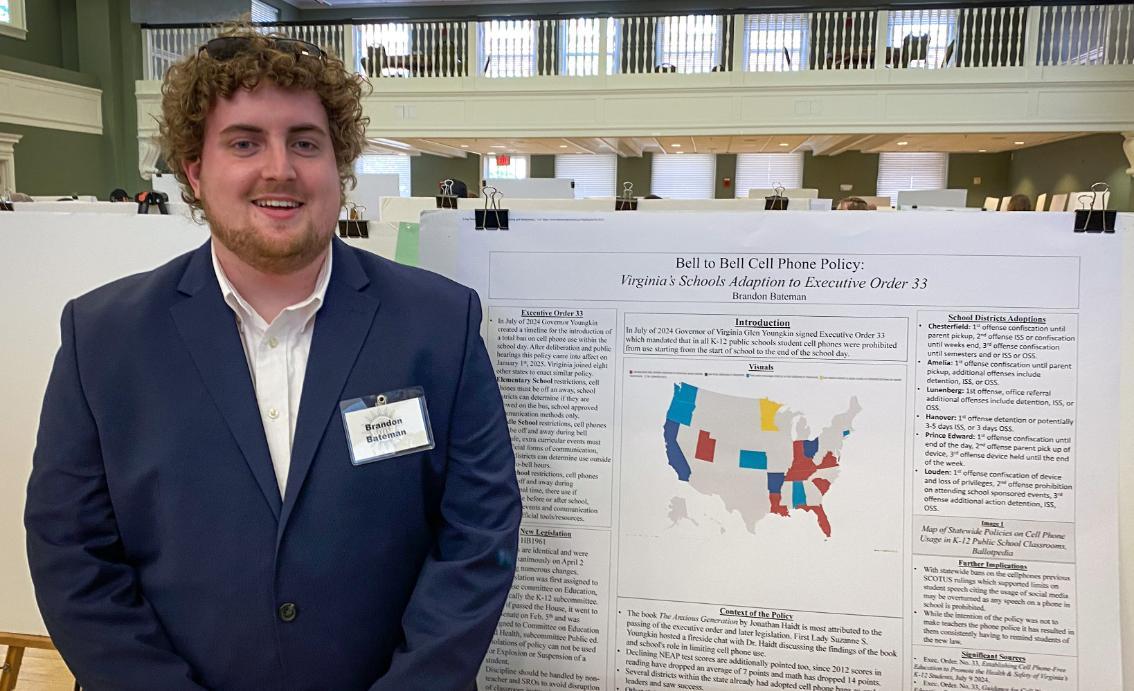
Virginia may be for lovers—but not for lovers of cellphones, at least not those who think K-12 students should have access to them during the school day. Virginia’s law—one of the strictest in the U.S. and passed unanimously by its lawmakers—prohibits the use of cellphones at any time during the school day, including during lunch and between classes.
Brandon Bateman ’26, a history/secondary education major, looked at school cellphone policies across the country as part of his research on the implementation of Virginia Gov. Glenn Youngkin’s Executive Order 33 calling for “cellphone-free education” and the subsequent legislation passed unanimously in the Virginia House and Senate. That unanimous support is what Bateman found most surprising in his research.
“Phones in Schools, how Students and Counties are Adapting to Executive Order 33”
Cormier Honors College for Citizen Scholars (Dr. David Geraghty)
You never know what’s living on your kitchen sponge
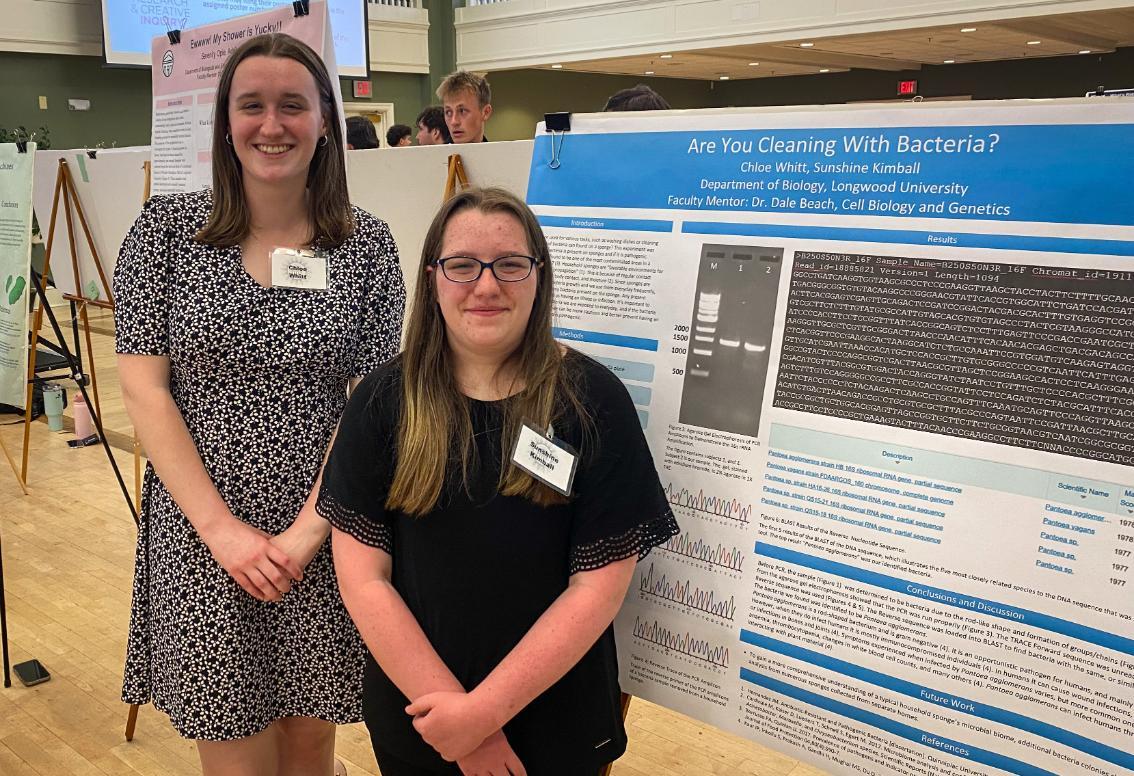
That sponge you’re using to “clean” your kitchen counters may actually be spreading bacteria.
Those are the results research conducted by Chloe Whitt ’27, a biology major, and Sunshine Kimball ’28, a chemistry/biochemistry major.
A single swab taken from a sponge used in their professor’s kitchen was teeming with different types of bacteria. They zeroed in on an area less than 1 millimeter in diameter and were able to collect and identify the DNA of an opportunistic pathogen. That particular bacteria most often infects plants—rarely humans—but that was just one of many bacteria living on one tiny area of the sponge.
Words to the wise: “Sponges are a very favorable environment for bacteria,” said Witt.
“Are You Cleaning with Bacteria?”
BIOL 250: Introduction to Genetics and Cell Biology (Dr. Dale Beach and Dr. Cristian Danna)
Switching to blue light will attract fewer insects—and maybe help save the planet
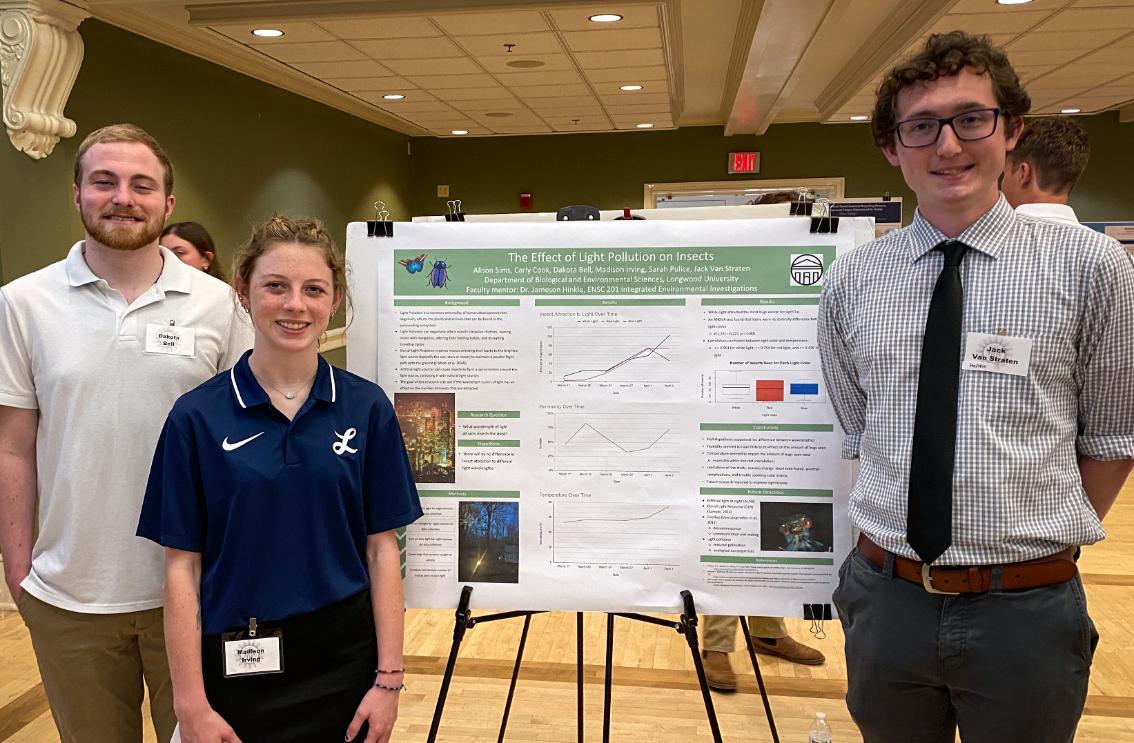
Some scientists estimate that insects have declined by 75 percent in the past 50 years, a trend that could have dire consequences on Earth—all the way up the food chain to humans.
Based on their research, a team of six student scientists at Longwood have a suggestion that might help: Reduce artificial white light pollution by replacing it with blue light. Most artificial light sources—including street lights and outdoor lighting—are white light, which mimics natural light, said team member Jack Van Straten ’25, an environmental sciences major.
Just look at the insects buzzing around a street light after dark, and you can see what havoc this wreaks on insect behavior—possibly even hindering their reproductive abilities, he said. In their research, the student team, which included Dakota Bell ’27 and Madison Irving ’28, both environmental sciences majors, found that blue light attracted a smaller number of insects. Even with questions about blue light, the impact of light pollution on insects should definitely be part of the discussion, they say.
“The Effect of Light Pollution on Insects”
ENSC 201: Integrated Environmental Inquiries (Professor Jameson Hinkle)
Long nails are more likely to cause infections in health care settings
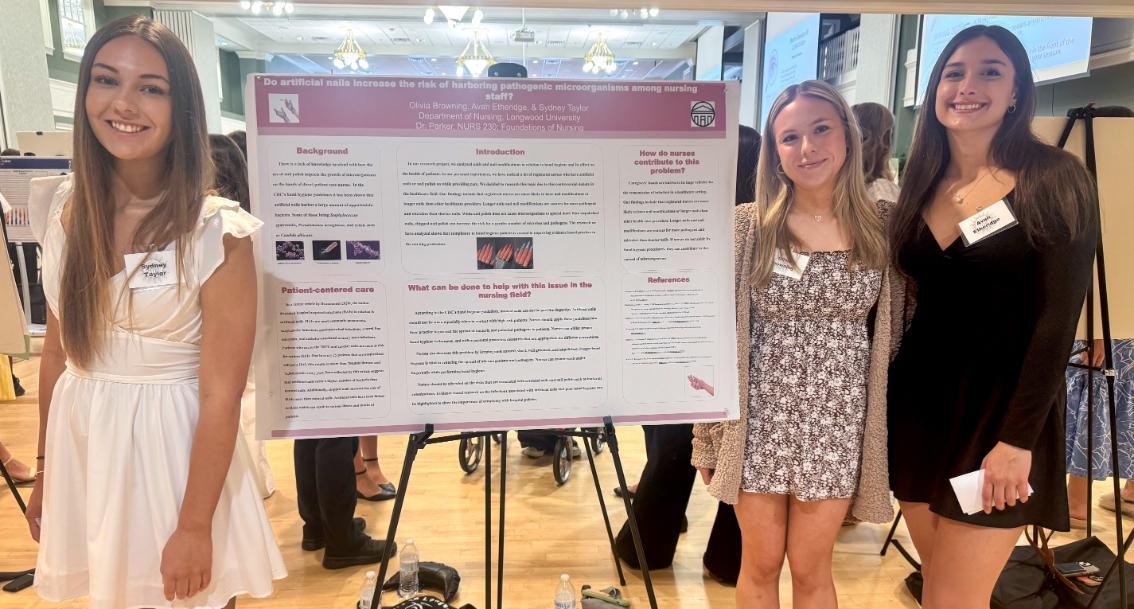
One in every 25 patients hospitalized will get an HAI (hospital acquired infection). Nursing students Olivia Browning ’27, Sydney Taylor ’27 and Avah Etheridge ’27 found that artificial nails harbor larger amounts of opportunistic bacteria than natural nails and therefore could be a source of infection in health care settings via the hands of direct patient-care nurses.
“How Artificial Nails Pose a Risk in Health for Patients in the Field of Nursing”
NURS 230: Foundations of Nursing Practice (Dr. Elizabeth Parker and Dr. Pamela Compton-Dooley)
Ditching your alarm clock could help reduce stress levels
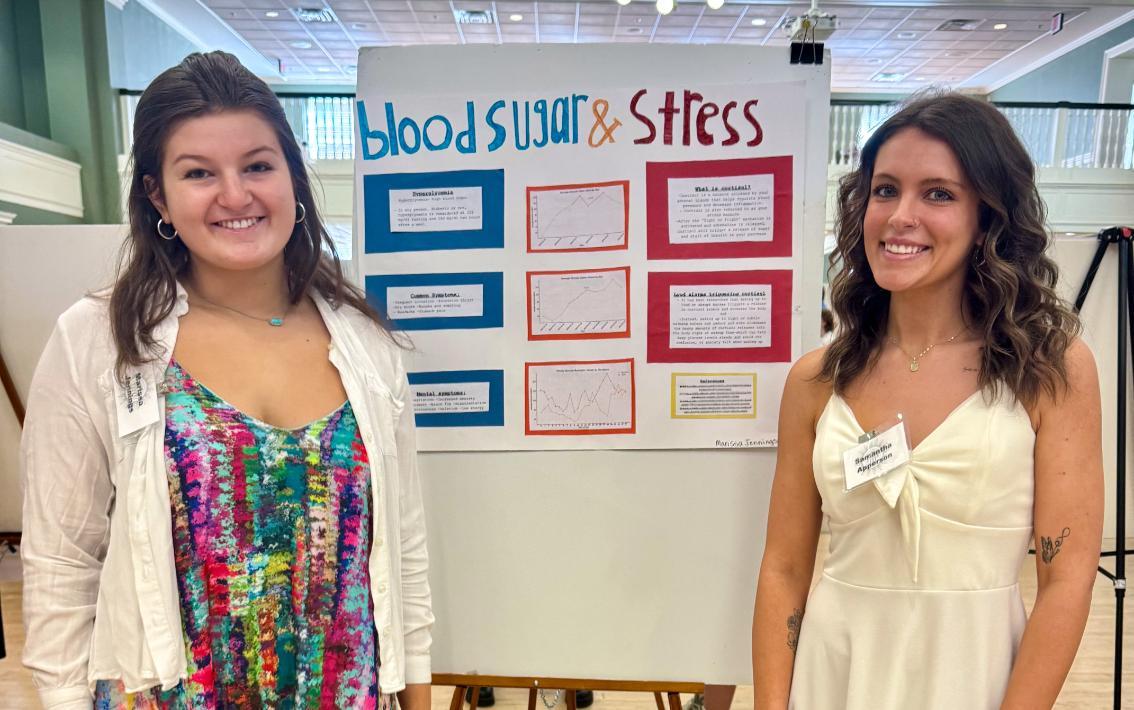
Research shows that waking up to loud or abrupt noises triggers a release in cortisol levels and stresses the body out. This was among the findings of the research conducted by Marissa Jennings ’27 and Samantha Apperson ’27, both kinesiology majors, who looked at the correlation between cortisol (stress hormone) levels and blood sugar. They recommend waking up to light or subtle calming noises, which can reduce and even eliminate the amounts of cortisol released into the body right at wake-up time.
“Correlation between Blood Glucose and Cortisol Levels”
Independent Research (Dr. Bjoern Ludwar)
Someone you know may be experiencing food insecurity
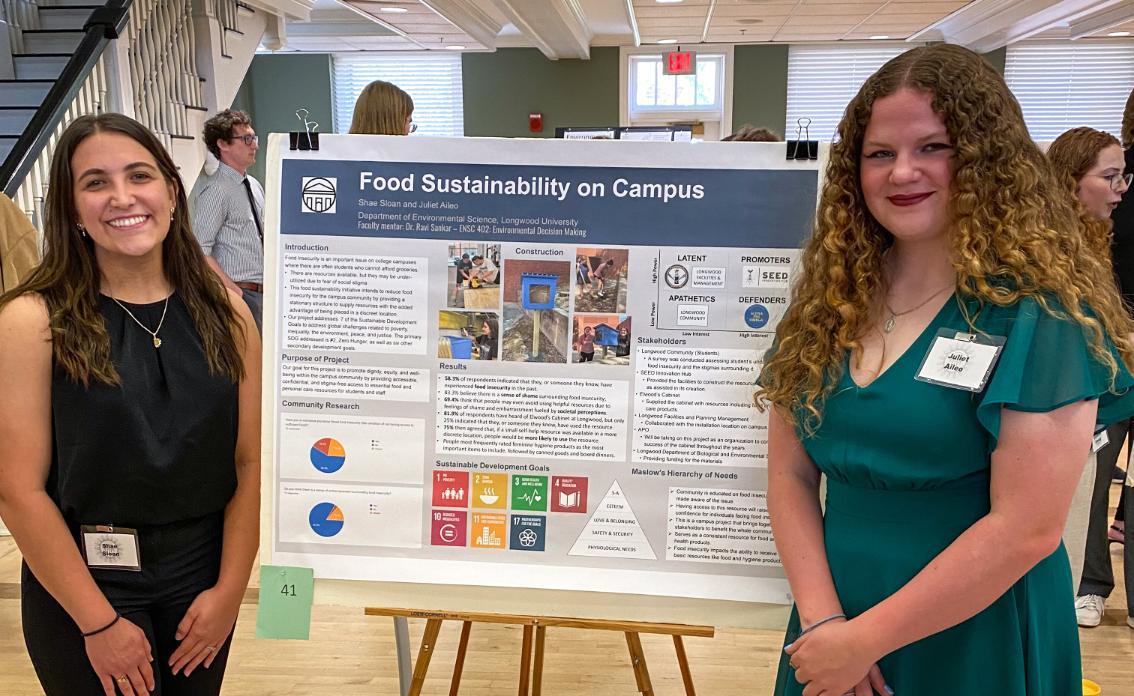
Food insecurity may be more widespread than many people think, according to research conducted by two Longwood students.
Juliet Aileo ’26 and Shae Sloan ’25, both environmental sciences majors, surveyed Longwood students about food insecurity, which is defined as not having access to sufficient food, or food of an adequate quality, to meet one’s basic needs. Of the 125 who responded, 58.3 percent said they, or someone they knew, had experienced food insecurity.
That’s one reason Aileo started volunteering with Elwood’s Cabinet, a student-run emergency food pantry created to ease food insecurity and the need for other basic necessities among the student body.
“Relieving Food Insecurity with a Campus Food Pantry”
ENSC 402: Environmental Decision Making (Dr. Ravi Darwin Sankar)
Lights and dark play a critical role in hospital patient health
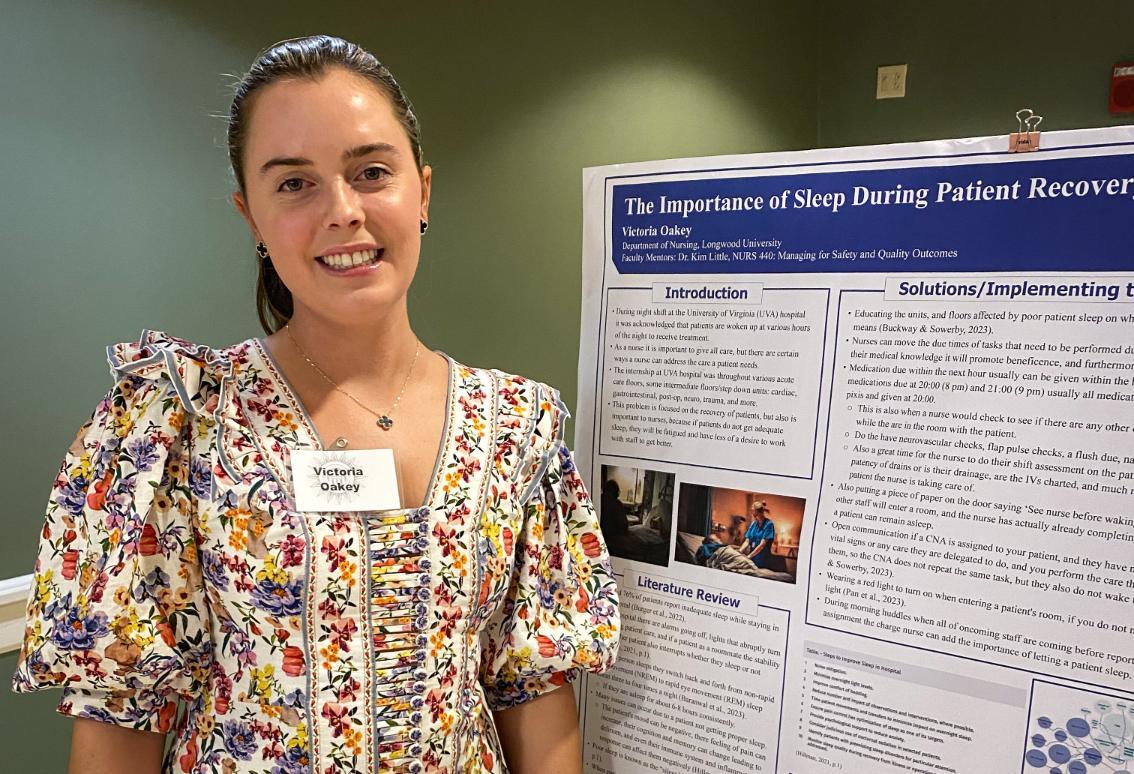
A less disruptive light source might be just as important a piece of standard equipment for nurses working the night shift as a stethoscope.
Why? It could promote better sleep for patients, says Victoria Oakey ’25, a nursing major who did her internship working the night shift on several acute care floors at a UVA hospital. Oakey is passionate about the importance of sleep for patients and chose it for the topic of her research project.
“The saying is that it takes a week to recover from a day in the hospital. Patients who aren’t getting enough sleep in the hospital can experience delirium and a rise in [the stress hormone] cortisol,” she said, adding that long-term sleep deprivation can be a contributing factor to even more serious consequences.
At night, “normally the nurse goes into the patient’s room and turns the light on,” Oakey said. Instead, when she was on night shift, Oakey carried a device with her that emits a low but adequate level of red light. Red light is less bright and also is thought to be less disruptive to sleep by encouraging melatonin production and promoting relaxation.
Oakey hopes future research about the impact of sleep deprivation on patients can lead more hospitals to adopt practices that promote and protect sleep.
“The Importance of Sleep while Patients Recover”
NURS 440: Managing for Safety and Quality Outcomes (Dr. Kim Little)
HBCUs were the first higher education institutions to be coed
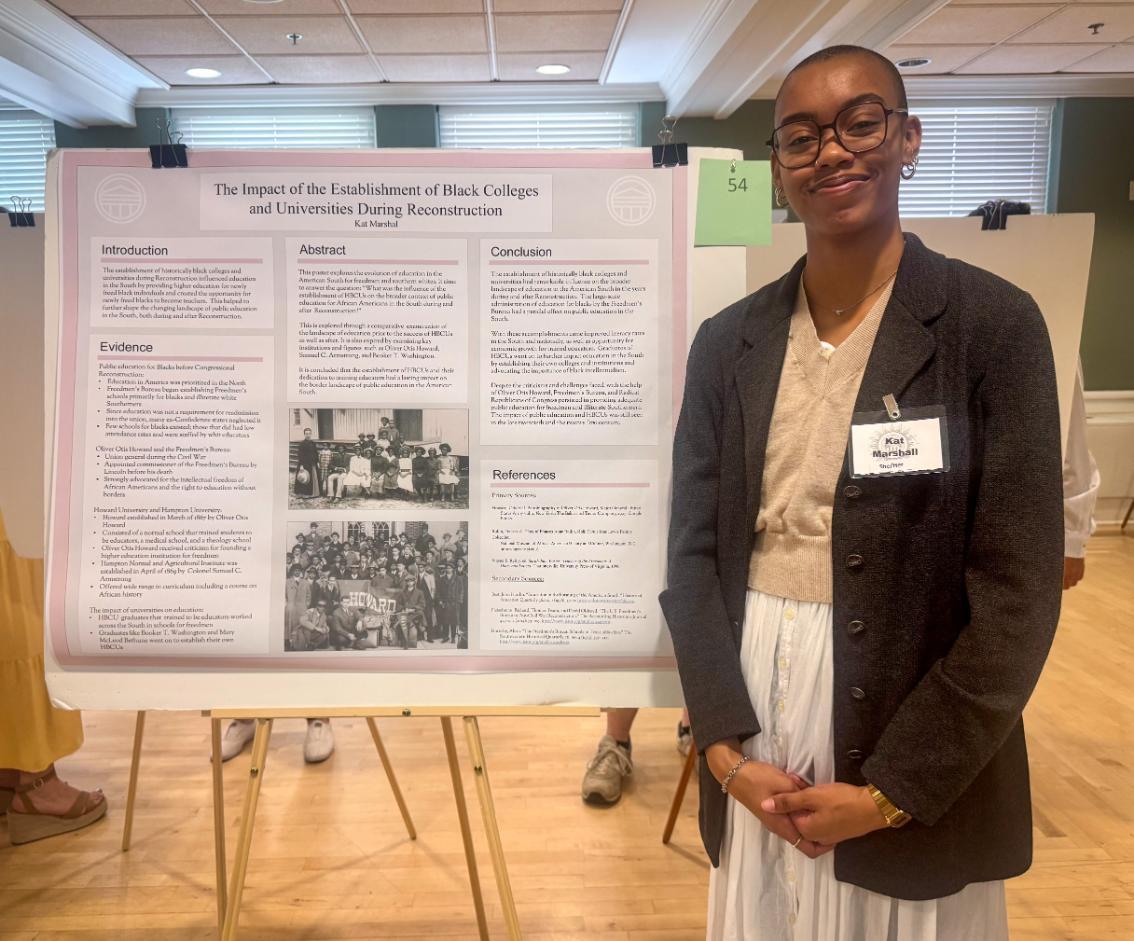
Kailyn “Kat” Marshall ’25, a history major, set out to look at the broader impact HBCUs had beyond higher education in the south during the Reconstruction period. One of her more interesting findings was that when the first HBCUs were established they were never segregated by sex.
“Black Education and the Establishment of Black Colleges and Universities During Reconstruction”
HIST 407: Seminar in U.S. History—Reconstruction (Dr. David Coles)
There is no modern equivalent to Mansa Musa’s wealth

Caleb Sullivan ’25, a history major, used his research project to explore Mansa Musa, the ninth king of the Kingdom of Mali, who is often considered the wealthiest person in history. Sullivan found Mansa Musa’s wealth has no modern equivalent and that during the king’s pilgrimage to Mecca his generous distribution of gold caused the price of the precious metal to plummet, disrupting local economies for years.
“Mansa Musa: The King Who Conquered the Economy”
HIST 414: History of Capitalism (Dr. Gregory Mole)
Deadly lung cancer is deadlier in rural areas
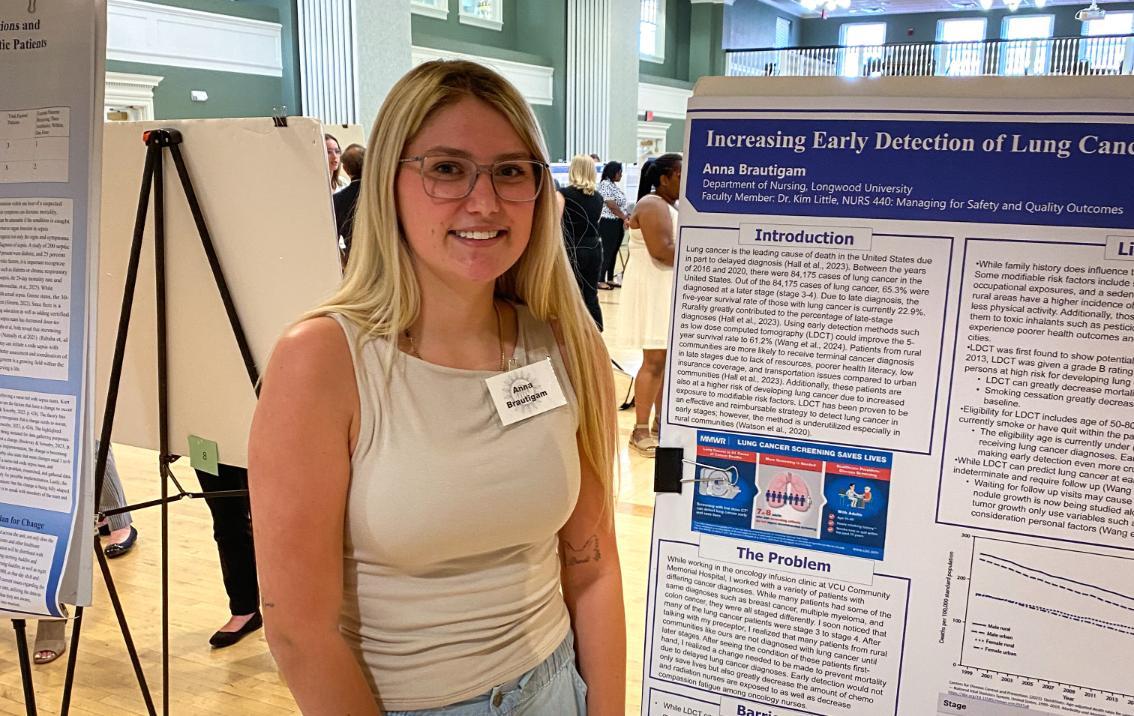
Anna Brautigam ’25, a nursing major, did her internship in a chemotherapy infusion clinic in Mecklenburg County, Virginia, a rural area. That experience inspired her to look more closely into the high percentage of lung cancer patients she saw at the clinic.
What she found was a deadly trifecta: (1) More than 50 percent of the total cases of lung cancer in the U.S. occur in rural areas, (2) 65.3 percent of those cases are diagnosed in Stage 3 or Stage 4 and (3) consequently the five-year survival rate for patients in rural areas is lower than in average rate of about 28 percent.
This could be attributable to a combination of factors, including higher smoking rates, limited access to health care and socioeconomic disparities. The bottom line? “Living in a rural area is a risk factor for a diagnosis of lung cancer,” Brautigam said.
“Increasing Early Detection of Lung Cancer in Smokers from Rural Communities”
NURS 440: Managing for Safety and Quality Outcomes (Dr. Kim Little)
At least 90 species of frogs have gone extinct due to Batrachochytrium dendrobatidis (Bd).

Bd is a fungus that causes infectious disease in frogs, which are vital to ecosystems and serve as indicators of environmental health. Their disappearance can disrupt intricate food webs and have cascading effects throughout the ecosystem. Amanda Doty ’25, a biology major, set out to look at how heat-killed bacteria affect Bd growth to get a better idea of how the microbiome impacts the fungus’s behavior and how harmful it can be.
“Microbial Mischief: The Bacterial Influence on Frog Fungus”
Independent Research (advisor Dr. Amanda Starr)
Grieving for Two: Partners also need support after miscarriage and stillbirth
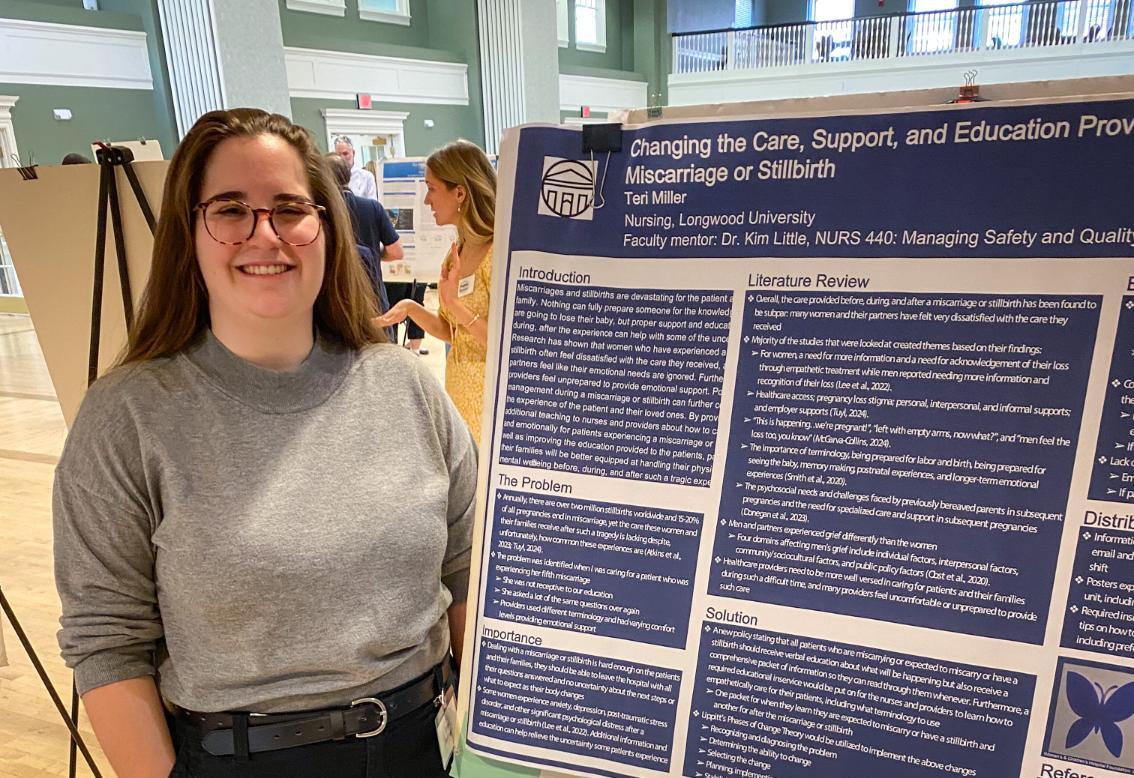
Statistics show that about 10-20 percent of pregnancies end in miscarriage and that 1 in 175 births results in stillbirth. Women who find themselves in that situation need more acknowledgment and recognition, Teri Miller ’25, a nursing major, found in her research.
But she also found that there can be an important person there with her, and that person, on top of experiencing the loss, often feels invisible as well.
“The woman’s partner may be experiencing that grief differently, but they also need support,” said Miller. “They say they feel pushed to the side. Men particularly say they feel they need to be strong and support their partner—but at the same time they don’t know how to grieve the loss themselves.”
“Changing the Care, Support, and Education Provided Before, During, and After a Miscarriage or Stillbirth”
NURS 440 – Managing for Safety and Quality Outcomes (Dr. Kim Little)
Pipe fragments reveal trade was prominent up and down the east coast among indigenous inhabitants.
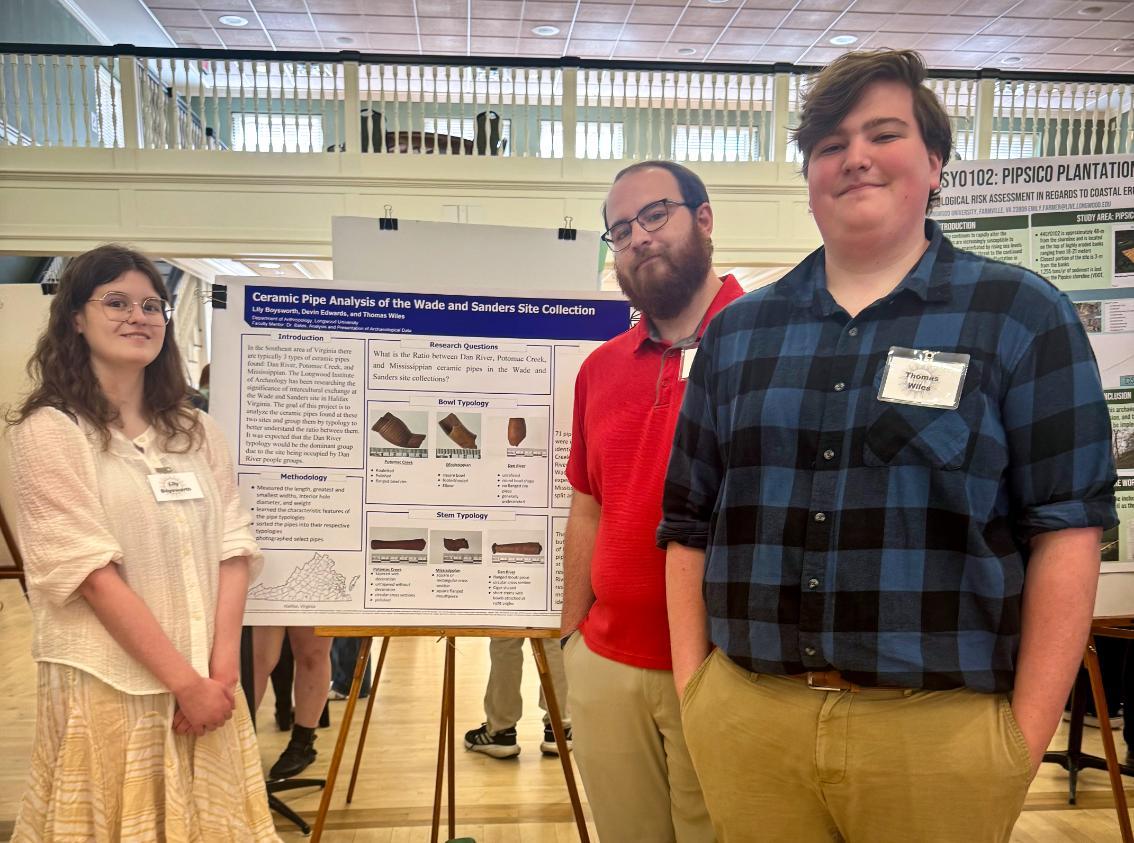
Lily Boysworth ’25, Devin Edwards ’25 and Thomas Wiles ’25, all anthropology majors, analyzed 71 ceramic pipe fragments found at two Longwood archaeology dig sites in Halifax, Virginia. The pipes were classified as one of three types: Potomac Creek, Mississippian and Dan River. They hypothesized that the Dan River pipes would be more prominent in the sample due to the fact they were local to the people who inhabited the area. Their findings showed that there were only slightly more Dan River pipes and that the Potomac Creek and Mississippian were almost evenly split. This indicates a wide range of trade at the two dig sites as ceramic pipes were a sought-after item for trading during the pre-Columbian period among indigenous inhabitants.
“Ceramic Pipe Analysis of the Wade and Sanders Site Collections”
ANTH 470: Analysis and Presentation of Archaeological Data (Dr. Brian Bates)

Leave a Comment